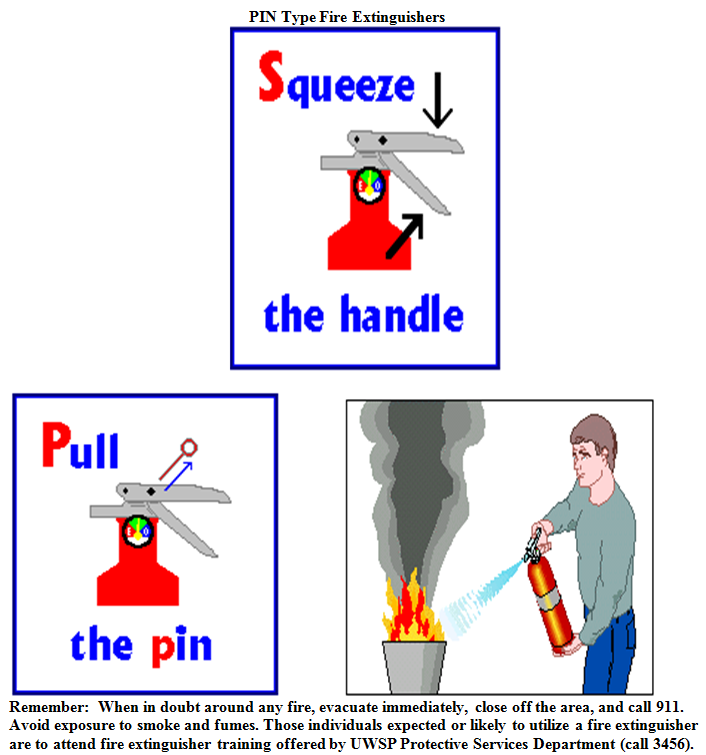The
purpose of this training is to familiarize employees with the general
principles of fire extinguisher use and the hazards involved with incipient
stage fire fighting. All employees must
tour their area and note the type(s) and locations of the fire extinguishers in
their Departments.
Used
properly, a portable fire extinguisher may save lives and property by putting
out small fires or containing fires until the fire department arrives. Knowing how to use a fire extinguisher is
essential not only in the workplace, but also in your home. This information will help employees properly
choose and use a fire extinguisher. However, hands-on training with UWSP
Protective Services is required.
General Information
Individuals
should only attempt to extinguish
fires that are in the INCIPIENT STAGE
(the fire is just beginning). DO NOT
attempt to extinguish fires that are large or out of control. Trained individuals may only handle this type
of fire. You must evacuate the area and
dial 911 if a fire is beyond its
incipient stage.
General Fire Fighting Rules:
·
Always call the fire department no matter how
small the fire is.
·
Never Fight a Fire that is beyond the incipient
stage.
·
Never Fight a Fire if you don't know what is
burning
·
Never Fight a Fire if the fire is spreading
rapidly beyond the spot where it started
·
Never Fight a Fire involving flammable liquids.
·
Never Fight a Fire if you don't have adequate or
appropriate equipment
·
Never Fight a Fire if you might inhale toxic
smoke
·
Never Fight a Fire if your instincts tell you not
to.
·
Always position yourself with an exit or means of
escape at your back before you attempt to use an extinguisher to put out a
fire.
·
Always inform your Supervisor.
Choosing a Fire Extinguisher
Fire extinguishers are tested by laboratories and labeled
for the class of fire they are intended to extinguish. There are four classes of fires, A, B, C, and
D.
CLASS
A: Fires in ordinary combustible materials (wood, cloth, paper, rubber,
and many plastics).
CLASS
B: Fires in flammable or combustible liquids (i.e., gasoline, toluene, paint), flammable gases,
greases, oils.
CLASS
C: Fires involving energized electrical equipment including wiring, fuse boxes, and circuit
breakers. (NOTE: when electrical
equipment is de-energized, extinguishers for Class A or B fires may be used.)
CLASS
D: Fires involving combustible metals, (i.e.: magnesium potassium, powered aluminum,
zinc)
Some portable extinguishers will put out only one class of
fire, and some are suitable for two or three, but none is suitable for all
four. Extinguishers must be labeled so those users may quickly identify the
class of fire for which they may be used.
Be
sure you have the appropriate fire extinguisher for the fire you are attempting
to extinguish. *WARNING* IT IS VERY DANGEROUS TO USE A CLASS “A’ RATED
EXTINGUISHER ON A “C” CLASS FIRE.
However, if you encounter a class “A” fire and don’t have an
extinguisher with an “A” symbol, don’t hesitate to use a “B” or “C”
extinguisher. Then follow-up with a
class “A” extinguisher.
Using the Fire Extinguisher
When
using a fire extinguisher always keep your back to an exit and stand twelve
feet away from the fire. Follow the
four-step PASS procedure. If the fire does not go out
immediately, leave the area at once.
Pull
the pin OR Push Puncture Lever: This unlocks the operating lever
and allows you to use the extinguisher. Some extinguishers will have a pin and some will
have a puncture lever. Follow
instructions on your specific fire extinguisher.
Aim
low: Point
the extinguisher nozzle (or hose) at the base of the fire. Stand 10 feet away from fire.
Squeeze
the operating lever: This will discharge the extinguishing agent.
Sweep: Keep the
extinguisher aimed at the base of the fire and sweep back and forth until the
flames appear to be out.
All
fire extinguishers must be clearly marked with operating instructions. Operating instructions will vary from one
type of extinguisher to the next.
If
an extinguisher has been discharged or damaged for any reason, report it to UWSP
Facility Services.

